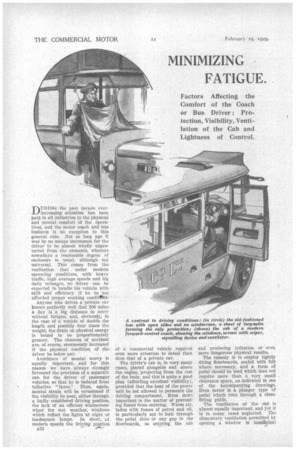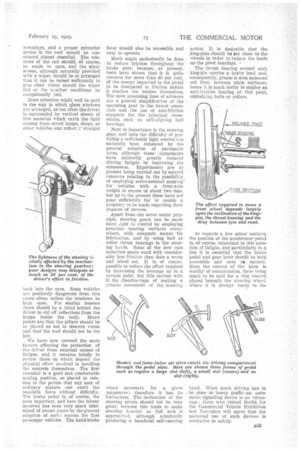MINIMIZING FATIGUE.
Page 102

Page 103

If you've noticed an error in this article please click here to report it so we can fix it.
1-11.11tING the past decade ever.1.linci-easing attention has been paid in all industries to the physical and mental comfort of the operatives, and the motor coach and bus business is no exception to this general rule. Not so long ago it was by no means uncommon for the driver to be almost wholly unprotected from the elements, whereas nowadays a reasonable degree of enclosure is usual, although not universal. This comes from the realization that under modern operating conditions, with heavy traffic, high average speeds and big daily mileages, no driver can be expected to handle his vehicle with skill and efficiency if he be not afforded proper working conditiffris.
Anyone who drives a private car knows perfectly well that 200 mile,: a day is a big distance to cover without fatigue, and, obviously, in the case of a vehicle of double the length and possibly four times the weight, the drain on physical energy is bound to be proportionately greater. The chances of accident are, of course, enormously increased if the physical condition of the driver be below par.
Avoidance of mental worry is equally important, and for this reason we have always strongly favoured the provision of a separate cab for the driver of passenger vehicles, so that he is isolated from talkative "fares." Then, again, mental strain will be occasioned if the visibility be poor, either through a badly considered driving position, the lack of an efficient windscreenwiper for wet weather, windows which reflect the lights at night or inadequate lamps. In short, at modern speeds the driving position D12 of a commercial vehicle requires even more attention to detail than does that of a private car.
The driver's cab is, in very, many cases, placed alongside and above the engine, projecting from the rest of the body, and this is quite a good plan (affording excellent visibility), provided that the heat of the power unit be not allowed to permeate the driving compartment. Even more important is the matter of preventing fumes from entering. Warm air, laden with fumes of petrol and oil, is particularly apt to leak through the pedal slots or any gap in the floorboards, so entering the cab
and producing irritation or even more dangerous physical results.
The remedy is to employ tightly fitting floorboards, sealed with felt where necessary, and a form of pedal should be used which does rot require more than a very small clearance space, as indicated in one of the accompanying drawings. Even better is a plunger type of pedal whichruns through a closefitting guide.
The ventilation of the Cab is almost equally important, and yet it is in many cases neglected. The elementary ventilation permitted by opening a window is insufficient
nowadays, and a proper extractor device in the roof. should be considered .almost essential. The windows of the cab should, of course, he made to open, and the windscreen, although naturally provided with a wiper, should be so arranged that it can be raised sufficiently to give clear vision should the wiper fail or the weather conditions be exceptionally bad.
More attention might well be paid to the way in which glass windows are arranged, as too often the driver is surrounded by vertical sheets of this material which catch the light corning from street lamps, shops, or Other vehicles and reflect it straight hack into the eyes. Some vehicles are positively dangerous from this cause alone unless the windows be kept open. For similar reasons there should be a blind behind the driver to cut off reflections from the lamps inside the body. Minor points are that the pillars should be so placed as not to obscure vision and that the roof should not be too low.
We have now covered the main factors affecting the protection of the driver from external causes of fatigue, and it remains briefly to review those on which depend the physical effort involved in handling the controls themselves. The first essential is a good and comfortable seating position, so placed in relation to the pedals that any man of ordinary stature can exert the requisite force without difficulty. The brake pedal is, of course, the most important, and here the labour involved has been very much minimized of recent years by the general adoption of servo motors for fast passenger vehicles. The hand-brake rover ahould also be accessible and easy to operate:
Much might undoubtedly be done to reduce friction • throughout the brake gear, because, . at , present, tests have shown that: it is quite common for more than 40 per cent. of the energy imparted to the pedal to be dissipated in friction .before it reaches the brakes themselves. The most promising lines of advance are a general simplification of the operating gear to the barest essentials and the use of anti-friction Supports for the principal crossshafts, such as self-aligning baIl bea rings.
Next in importance is the steering gear, and here the difficulty of providing a sufficiently light control PAS naturally been enhanced by the general adoption of pneumatic tyres, although these components have indirectly greatly reduced driving fatigue by improving the suspension. 'Experiments are at present being carried out by several concerr,s relating to the possibility of employing servo-assisted steeriag for vehicles with ..41 front-axle weight ira excess of about two tons, but up to the present these have not gone sufficiently far to enable a prophecy to be made regarding their chances of success.
Apart from -the servo motor principle, steering gears can be made more Light to Control by employing , generous bearing surfaces everywhere, with adequate means for lubrication, and by using ball or roller thrust bearings In-the steering hands. Some of the new cam reduction gears work with considerably less friction than doesa worm and wheel set. It is, of course, possible to reduce the effort required by increasing the leverage up to a certain point, but this carries with it the disadvantage of making a areater, movement of the steering wheel necessary for a given manoeuvre ; therefore it _has. its limitations. The inclination of the steering pivots should not be very great, because this tends to .make steering heavier -as full lock :s _approached, although admittedly producing a beneficial self-centring
action. It is desirable that the king-pins should be set close to the wheels in order to reduce the loads onsthe pivot bearings.
The thrust bearing around each king-pincarries a -heaVy load, and, consequently, grease is soon' squeezed out from between plain surfaces; hence it is much better to eniploy an anti-friction bearing at this point, embodying balls or rollers.
As regards a few minor matters, the position of the accelerator pedal is,of.course, important to this question, of fatigue, and particularly in a bus it is essential that the brake pedal and gear leer should he both accessible and easy to operate. Even the control of the horn is worthy of consideration, there being -much to be said for a ring control placed beneath the steering wheel, where it is always ready to the hand. When much driving hasto be done-. in -heavy • trailicaian. -automatic signalling device is an advantage ; those -who visited Berlin or the Commercial Vehicle • Exhibition last November will agree that the universal use of such devicesis conducive to safety.




























































































































































































































